The Spiny Flower Mantis (Pseudocreobotra wahlbergii) is a beautiful and eccentric mantis species from the east of South Africa. Known for its precious patterns and its wings with a spiral pattern resembling an eye, it comes in many tones depending on the environment.
Its naturally aggressive temperament and difficult breeding circumstances make the Spiny Flower Mantis fit for more experienced keepers, though beginners can also handle them if they have the time and patience for it.
Its beautiful resemblance to a flower makes it the perfect rose for your collection, as long as you keep the spines at bay. Here is everything you need to know about the dazzling Spiny Flower Mantis in case you’re interested in getting one of these beautiful insects!
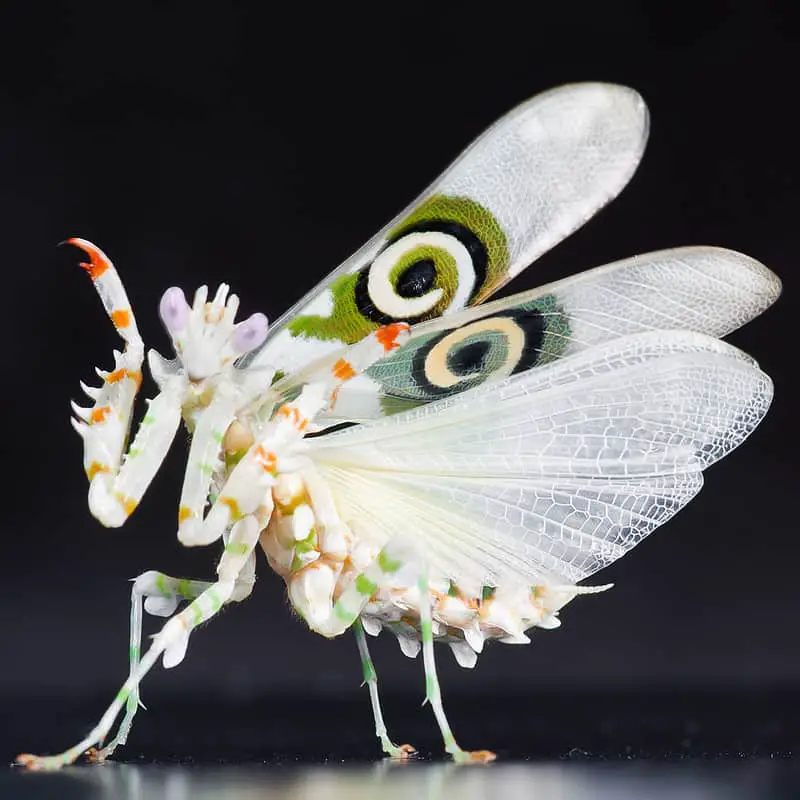
Spiny Flower Mantis Fact Sheet
| Name of species | Pseudocreobotra wahlbergii |
| Family | Hymenopodidae |
| Common name | Spiny Flower Mantis |
| Category | Mantis |
| Type | Macropterous, Flower Mantis |
| Native location | South Africa |
| Temperature | 77°F to 86°F |
| Humidity | 40% to 60% |
| Size | 1.5 to 2 inches (4 to 5 cm) |
| Diet | Small flying insects |
| Lifespan | 10 to 14 months |
| Experience level | Beginner – Intermediate |
Spiny Flower Mantis Overview
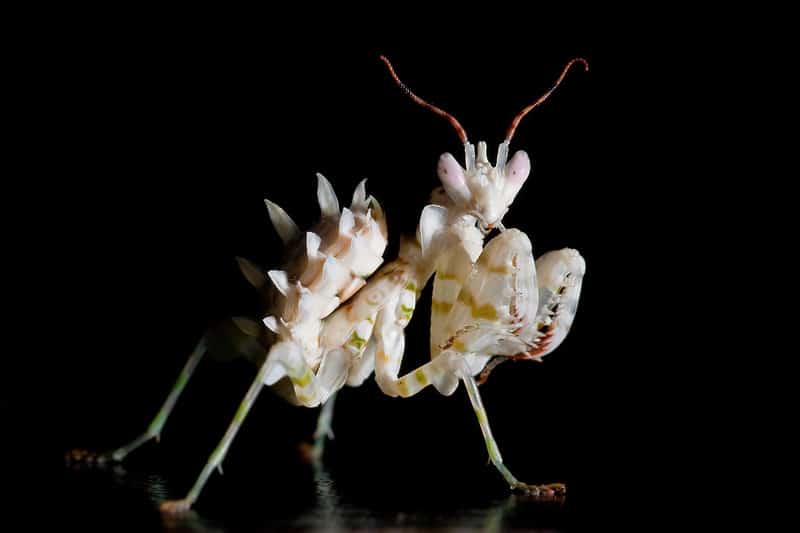
The Pseudocreobotra wahlbergii, more commonly known as the Spiny Flower Mantis, is a mantis species that is native to the south African area, more specifically the eastern side.
It has long wings that can fly great distances, making it a Macropterous type, and it tends to use these wings as a defense mechanism.
It’s also classified as a Flower Mantis because of its beautiful camouflage. Disregarding its small size, the Spiny Flower Mantis can feed on prey three times its size, so it tends to be a heavy eater in captivity.
Appearance & Variations
The Spiny Flower Mantis (SFM) is a flower mantis with a gorgeous, distinctive appearance. Commonly known to have a green and white stripe pattern all over its body, white is its primary color.
However, depending on the environment, it can adopt many tones, from pinkish to even yellowish, to blend the classic snowy hue into a new and exciting outline.
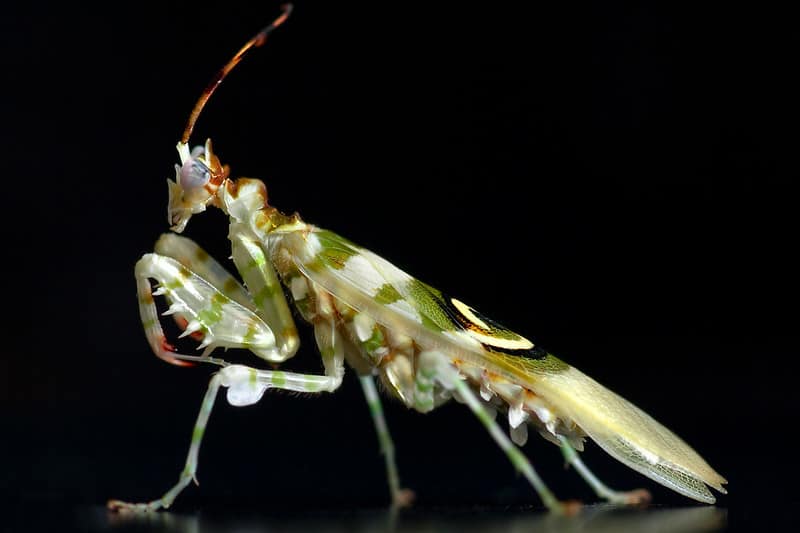
The spiky structures come from the abdomen, hence the name. As with all other mantids, the SFM has blade-like forelegs for apprehension and feeding. It has two pairs of wings; the first pair has two black and yellowish lines in a spiral with a purplish center, resembling an eye, and the second pair is transparent and fit more for flying purposes.
The eye-like wings are used for defense, displaying them in front of predators to resemble a larger animal, which can help scare off predators that are trying to eat them.
Males and females greatly resemble each other. The males are a little bit tinier than females and tend to have spiky structures all over their abdomen, while females have fewer spikes, and these are more ventrally distributed.
There isn’t a detailed feature to tell males and females apart, so sexing this species is difficult for the untrained eye.
Price
The Spiny Flower Mantis price range goes around $15 to $30 for early stages, depending on the demand.
More mature specimens can be bought for $25 up to $32, but full-grown adults vary from $35 to $38 in some cases.
The price tends to stay under $50 due to its short life span, but it’s still a glamorous and dazzling species, so the cost remains stable due to high demand.
Behavior and Temperament
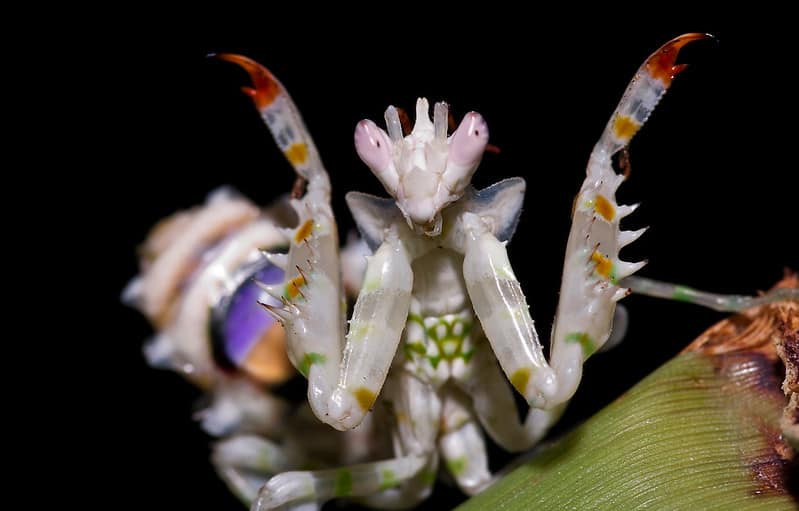
Then Spiny Flower Mantis is notorious for being skittish and mildly aggressive to other species and specimens.
It frequently displays cannibalism, which means you can’t have more than one of them in the same enclosure.
It’s an excellent hunter. It camouflages as a flower so flawlessly that most prey can’t tell it apart from the actual plant.
In addition, this species is an excellent flyer that is able to travel long distances while looking for the ideal spot to stalk its next prey. There, it will wait until the prey approaches and catch it off-guard, but it’s able to fight long battles if it needs to.
One of its most distinctive performances is its threat pose. Once a predator is detected, it will spread its forewings high enough to startle the aggressor with the eye-like patterns on its wings, looking bigger and more threatening than it actually is.
In most cases, this is enough to deter the predator and make it flee. Despite its apparent bravery, the Spiny Flower Mantis gets frightened rather easily, so caution is advisable while handling them; also, disengage any attempts to approach it if you see its threat pose, as it means it’s stressed.
Even in the worst-case scenario, this mantis is not venomous or poisonous, making it harmless to human beings.
Caring for a Spiny Flower Mantis
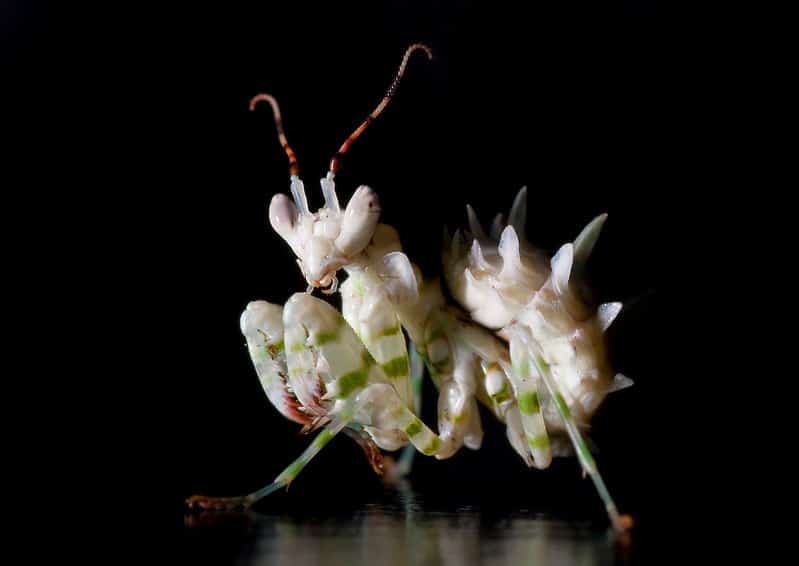
Temperature and Humidity
The Spiny Flower Mantis lives at high temperatures with moderate humidity. Temperatures ranging from 77°F to 86°F are enough to keep it comfortable during the day, with 64°F being preferable at night.
Humidity can go between 40% to 60% in most cases.
Moderate moisture and plenty of ventilation are essential to keep them lively and healthy.
Substrate
Like most Mantids species, 1 to 2 inches of substrate are enough to keep them comfortable. They like hot environments with a certain grade of relative humidity, so coconut fiber and shredded bark mixed with soil are the best choices for them while spraying regularly.
Tank
The setup for the enclosure is pretty straightforward, keeping in mind just a few tips. As these mantids are best kept alone, an enclosure that’s thrice as long as the SFM, three times as wide, and three times as tall as it is long should be enough for them. Nevertheless, a bigger enclosure can’t hurt.
Good ventilation is also necessary to keep this mantis healthy, so ensure your tank has enough ventilation holes.
As for the decoration, your SFM’s tank must have a branch or twig big enough for your SFM to climb and hang upside-down.
Fake plants, flowers, and foliage are also excellent choices to keep it comfortable; remember that it spends plenty of time in camouflage, so give it places where it can stay hidden, and it’ll be happy.
Watering
Spraying three times per week is essential for survival to keep your SFM healthy in its new home. It’s going to receive most of its hydration from its diet, but it’ll also drink from droplets in leaves and branches around the habitat; therefore, spraying it is important.
However, be mindful not to overdo it since mold is dreadful for this species. Be vigilant for any signs of mold formation, replace the substrate, clean the enclosure, and adjust spraying habits accordingly. Furthermore, adequate ventilation is very important to prevent mold and bacterial growth.
Diet of a Spiny Flower Mantis
The Diet for the Spiny Flower Mantis is straightforward as it’ll feed on anything that moves and is the right size.
During the first stages of maturity, from L1 to L2, small fruit flies are the best choice since they are healthy for mantids and quite affordable. L3 to L4 nymphs can be introduced into large fruit flies, using their abdomen as a reference to make sure you don’t overfeed them. From L5 until adulthood, blue bottle flies are the best choice.
Keep in mind that even though they can eat different and even larger types of insects, nothing replaces a fly-based diet since it prevents many diseases from other variants of prey like crickets and grasshoppers.
However, you can add other small-flying insects such as moths or ladybugs for variation every once in a while.
It’s important to note that you must feed your mantis live prey. They will not eat dead insects. In addition, you should make sure that you only feed them captive-bred prey. Wild-caught prey can contain parasites that can be harmful to your mantis.
Molting
When your Spiny Flower Mantis is about to molt you will notice that it will hang upside down motionlessly. During this time, it’s essential that you do not disturb them as molting is a stressful time for them. If the molt goes wrong, they can even lose limbs.
You’ll also notice that your mantis will stop eating right before a molt. This is normal behavior and nothing to worry about. Also, right after a molt, their exoskeleton is very soft and not fit to handle prey items. As a result, refrain from feeding them for around 24 hours after a molt. You should also refrain from handling them for around 48 hours after a molt because they’re very vulnerable and easy to injure during this time.
Lifespan & health
The Spiny Flower Mantis is unfortunately quite susceptible to disease. However, if you provide them with the diet and enclosure that we’ve described above they should do fine and live a long and healthy life. They typically reach an age of around 10 to 14 months when cared for properly.
To keep them healthy, the following things are very important:
- Remove uneaten food
- Provide adequate ventilation and humidity
- Feed only captive-bred insects
- Handle with care
Social
The Spiny Flower Mantis is not a social species and they’re very aggressive towards other members of their species. They should never be kept communally as this is very likely to result in cannibalism.
In the wild, these insects meet only when it’s time to mate, and even that often ends in cannibalism.
As a result, the same solitary lifestyle should apply in captivity. To keep your mantis safe, make sure that you never house more than one of them in a single enclosure.
If you’re interested in a communal species, I recommend checking out the Ghost Mantis instead.
Interesting Facts about the Spiny Flower Mantis
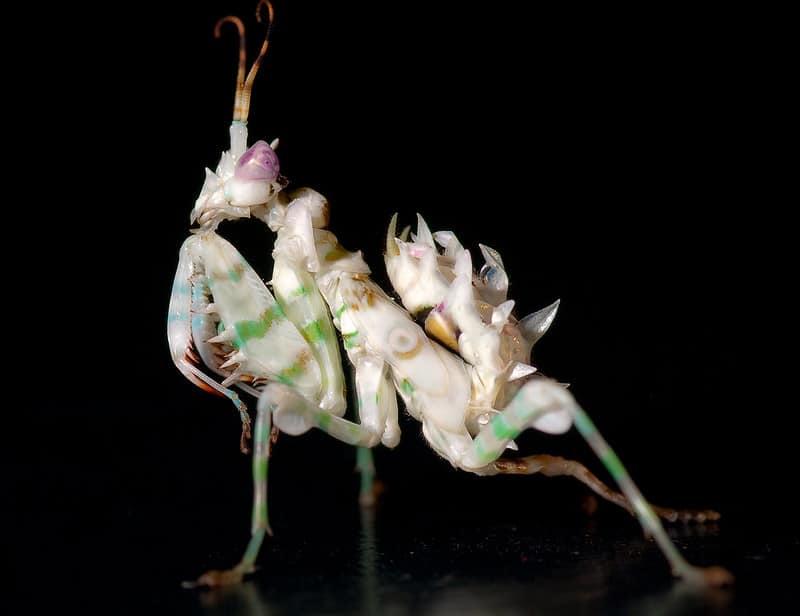
- The Pseudocreobotra wahlbergii is known as the Spiny Flower Mantis due to the spiky structure protruding from its abdomen. If you look at it from the right angle, it passes as a flower almost perfectly. It’s also commonly compared with a dragon fruit due to its spiky appearance and different colors.
- The Spiny Flower Mantis is particularly prone to diseases. It’s very susceptible to mold formation and other disadvantageous circumstances. Therefore, beginners might want to get more experience with other mantids and insects before trying to keep this particular species.
- The SFM’s aggressive behavior makes it difficult to breed. Ideal environmental conditions must be met, and both specimens must be well-fed before attempting to mate.
Final Words
The Spiny Flower Mantis could be romantically referred to as a white rose mantis. Due to its gorgeous display with the thorny texture to denote its temperament.
The less experienced keeper might find this particular species quite challenging, but even for beginners, they can be suitable if you’re willing to put in the time and effort to provide them with what they need.
They’re definitely worth it though, the stunning colors and high-class patterns that this species displays make it the perfect ornament in your collection.
We hope this article has everything you need to know to decide if this flower is the perfect fit for you. If after reading this you feel like the SFM is not a good fit, you might want to check out the Chinese or Carolina Mantis instead!
- How Long Do American Eskimo Dogs Live? Important Factors and Care Tips - September 29, 2023
- Do American Bulldogs Need Grooming? Essential Tips and Care Guidelines - September 29, 2023
- Do Bengal Cats Enjoy Playing? Essential Tips for Keeping Them Active - September 29, 2023